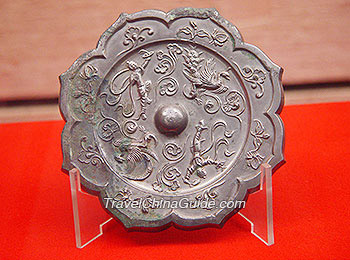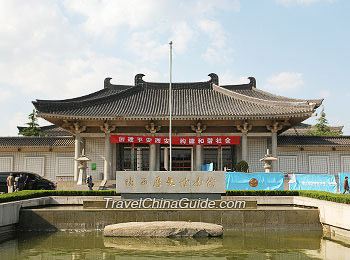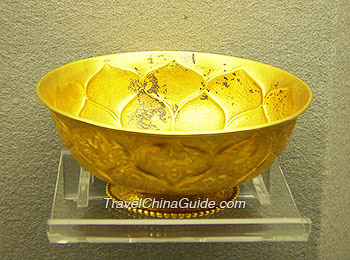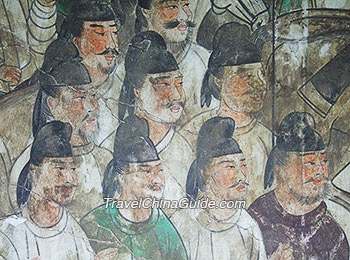Shaanxi History Museum
The Shaanxi History Museum in Xi'an, regarded as “the pearl of ancient dynasties and house of Chinese treasures”, gives a miniature overview of the thousands of years of Chinese history and the splendid ancient cultures of olden times.
Situated on Xiaozhai East Road on the northwest side of Giant Wild Goose Pagoda, the Shaanxi History Museum is the first modern national museum. It was built in 1983 and opened to the public in 1991. Shaanxi History Museum covers 65,000 square meters (16 acres), of which 11,000 square meters (2.7 acres) belong to the exhibition halls and 8,000 square meters (about 2 acres) are used as warehouses for storing relics. Now 1,700,000 exhibits in the museum vividly show the history of over a million years from prehistoric times (c. 1.63 million years ago - 21st century BC) to about 1911 AD.
The grand buildings of Shaanxi History Museum imitate the architectural style of the Tang Dynasty (618 - 907) with a two-storied central hall and four worship halls around it. The predominant colors of the halls are black, white and grey, which give the halls an atmosphere of solemnity and rustic charm.
The exhibition halls of Shaanxi History Museum are generally divided into four main groups: the preface hall, the permanent exhibition halls, the theme exhibition halls, and the temporary exhibition halls.
 Must-See Cultural Relics
Must-See Cultural Relics Must-See Cultural Relics
Must-See Cultural Relics Must-See Cultural Relics
Must-See Cultural RelicsNo.4 Exhibition Hall – 1F
 Must-See Cultural Relics
Must-See Cultural Relics Must-See Cultural Relics
Must-See Cultural Relics
The newly-built Qin Han Museum of the Shaanxi History Museum is about a 30-minute drive from Xi'an Xianyang International Airport. It is dedicated to the origin, development and contributions of the civilization during the Qin and Han Dynasties (221 BC - 220 AD). Currently, over 1,500 cultural relics are on display, 90% of which are being exhibited for the first time. Here you can see China's earliest wooden boat artifacts - the “Silk Road No. 1” Wooden Vessel, the Golden Monster, the Tiger-Shaped Tally of Du, and other national treasures.
Note: Tickets for the Murals Treasures of the Tang Dynasty can only be purchased on-site after you have reserved and entered the Shaanxi History Museum.
The museum’s daily visitor capacity is 12,000, increasing to 14,000 from April 1 to October 31, 2025. Tickets are released five days in advance at 17:00. You can make a reservation through the WeChat official account of the Shaanxi History Museum, but it has no English version and the reservation is difficult due to the number limit. It is recommended that you make a reservation with the help of a third-party travel agency to ensure the smooth progress of your visit plan. Alternatively, you can consider the Qin Han Museum of Shaanxi History Museum as an alternative, where tickets are relatively easy to book.
2 - 3 hours
Tip: It is recommended not to visit this museum in July and August, because this period is China's summer vacation, and many parents will bring their children to visit and study, making it too crowded.
Situated on Xiaozhai East Road on the northwest side of Giant Wild Goose Pagoda, the Shaanxi History Museum is the first modern national museum. It was built in 1983 and opened to the public in 1991. Shaanxi History Museum covers 65,000 square meters (16 acres), of which 11,000 square meters (2.7 acres) belong to the exhibition halls and 8,000 square meters (about 2 acres) are used as warehouses for storing relics. Now 1,700,000 exhibits in the museum vividly show the history of over a million years from prehistoric times (c. 1.63 million years ago - 21st century BC) to about 1911 AD.
The grand buildings of Shaanxi History Museum imitate the architectural style of the Tang Dynasty (618 - 907) with a two-storied central hall and four worship halls around it. The predominant colors of the halls are black, white and grey, which give the halls an atmosphere of solemnity and rustic charm.
 |
The exhibition halls of Shaanxi History Museum are generally divided into four main groups: the preface hall, the permanent exhibition halls, the theme exhibition halls, and the temporary exhibition halls.
Preface Hall - 1F
Once you enter the central hall, you will be in the Preface Hall, where stands a replica of a stone lion from the Shunling Tomb of the Tang Dynasty and a huge picture of a loess plateau and the Yellow River. Behind the picture you will find the permanent exhibition halls.
Permanent Exhibition Halls
Permanent Exhibition Halls in Shaanxi History Museum show the Shaanxi's culture in the timeline in three exhibition halls and seven units separately.
No.1 Exhibition Hall - 1F
1. Tripod (Ding) of Yu; Cauldron
Western Zhou Dynasty (1046 BC - 771 BC)
A round bronze tripod with beast face patterns.
2. “Fifth-Year” Tripod (Ding) of Wei; Cauldron
Western Zhou Dynasty (1046 BC - 771 BC)
A bronze tripod with over two hundred characters engraved inside.
|
|
- Unit 1: The Cradle of Chinese Civilization
Prehistoric Period (c. 1.63 million years ago - 21st century BC)
This unit showcases the formation and evolution of ancient humans and their survival and development in this region through the remains of ancient humans such as the Lantian Man and Dali Man, as well as early cultural relics like the Banpo Site and Jiangzhai Site, dating back approximately 1.15 million years.
- Unit 2: Grandeur of the Zhou Dynasty
Western Zhou Dynasty (11th century BC - 771 BC)
The rich relics and artifacts in Shaanxi, which served as the capital of the Western Zhou Dynasty, showcase the political system, economic structure, and bronze casting techniques of that period.
- Unit 3: The Eastern Empire - Qin
The Qin Dynasty (770 BC - 207 BC)
The key exhibits are Qin artifacts represented by the Terracotta Army, which, with their imposing momentum and distinct military characteristics, demonstrate the strong pioneering consciousness and enterprising spirit of the Qin people.
No.2 Exhibition Hall - 2F
1. Gilt and Silvered Bronze Incense Burner with a Bamboo-shaped Stand
Han Dynasty (206 BC-220 AD)
A gilded and silvered bronze incense burner with two dragons carved on the base.
A gilded and silvered bronze incense burner with two dragons carved on the base.
2. The Empress’ Jade Seal
Han Dynasty (206 BC-220 AD)
A jade seal inscribed with the characters “Huang Hou Zhi Xi”, was once the seal of Empress Lv Zhi of the Han Dynasty.
|
|
- Unit 4: Thriving of the Han Dynasty
The Han Dynasty (202 BC - 220 AD)
Through the capital Chang’an of the Han Dynasty, the imperial mausoleums and typical Han artifacts, this exhibition showcases the first peak of ancient Chinese social development - the prosperous economy, culture, openness and exchanges of the Han Dynasty, highlighting its era’s spirit of openness, progress, and strength.
- Unit 5: Conflict and Fusion
The Wei, Jin, Northern and Southern Dynasties (220 AD - 581 AD)
The rich and exquisite cultural relics and religious artifacts of agricultural and nomadic ethnic groups in Shaanxi demonstrate the great ethnic integration, the eastward spread of Buddhism, and the prosperity and characteristics of art and culture.
No.3 Exhibition Hall - 2F
1. Tri-Color Camel Carrying a Musical Band
Tang Dynasty (618-907)
This first-class cultural relic depicts a camel standing on a rectangular base, stretching its neck. The camel’s back is equipped with a platform-like saddle, carrying eight musicians.
2. Black-Glazed Bowl with Oil Drops Design
Song Dynasty (960-1276)
A large-mouth black glazed bowl with oil-drop-shaped crystals inside.
|
|
- Unit 6: Flourish of the Tang Dynasty
Sui and Tang Dynasties (581 AD - 907 AD)
Through typical relics of the Sui and Tang eras, this unit showcases the cultural landscape of the most prosperous period in ancient China: Chang’an, the most bustling international metropolis in the world at that time; the Silk Road, which facilitated exchanges between the East and the West; and the unprecedented heights reached by the Sui and Tang cultures through their inclusive and innovative development.
- Unit 7: Everlasting Glamour
Shaanxi after the Tang Dynasty (907 AD - 1911 AD)
This section showcases the unique historical sites left by Shaanxi, a key region in Northwest China, after the Tang Dynasty.
Theme Exhibition Halls
No.4 Exhibition Hall – 1F
Treasures of the Great Tang Dynasty - Unearthed Objects from the Hejia Village Hoard
1. Gold Bowls with Mandarin Ducks and Lotus Petals
Tang Dynasty (618 - 907)
A gold bowl weighing about 400 grams, is decorated with mandarin ducks and lotus patterns on its surface.
2. Agate Cup with Animal Head
Tang Dynasty (618 - 907)
A cup carved from agate in the shape of a beast head.
|
|
This exhibition brings together over 300 sets of precious artifacts unearthed from the Hejia Village Hoard, which are now in the collection of the Shaanxi History Museum. The hoard includes various gold and silver wares, jade and precious ornaments, rare medicinal materials, and coins from both China and abroad. These precious artifacts contain rich information, revealing the life of the Tang Dynasty from multiple perspectives and aspects such as politics, economy, ideology, culture, art, customs, and craftsmanship.
1. Tang Dynasty Officials Greeting Foreign Envoys Mural
Tang Dynasty (618 - 907)
A tomb mural depicting the scene of Tang Dynasty officials interacting with foreign envoys.
2. Mural of Polo Match
Tang Dynasty (618 - 907)
A tomb mural depicting ancient people playing polo on horseback.
|
|
The Tang Dynasty tomb murals are the unique and precious collections of Shaanxi History Museum. There are nearly 600 pieces of mural masterpieces from over 20 Tang Dynasty tombs, covering an area of over 1,000 square meters. Among them, 5 sets of 18 pieces are designated as national treasures, and 69 sets of 82 pieces are classified as first-class cultural relics. These paintings describe different aspects of the noble classes in the Tang Dynasty with their distinctive architectural styles, simple yet expressive figures, and distinctive objects, depicting how people lived during that time.
Temporary Exhibition Halls
Exhibition Halls 5, 6 and 7 of the museum are temporary exhibition halls, which occasionally hold exhibitions of historical relics of different themes and periods.
Qin Han Museum of Shaanxi History Museum on Qin & Han Civilizations
 |
| Pottery Figurines in Han Dynasty |
How to Tour the Shaanxi History Museum?
Route 1: Follow the timeline of historical development
-Route: No.1 Exhibition Hall - No.2 Exhibition Hall - No.3 Exhibition Hall - No.4 Exhibition Hall - Other Exhibition Halls
-Advantages: Following the chronological order of history, the artifacts from different periods can give you a clearer and more intuitive understanding of historical development.
-Disadvantages: Too crowded
Route 2: Less crowded
-Route: No.4 Exhibition Hall - No.3 Exhibition Hall - No.2 Exhibition Hall - No.1 Exhibition Hall - Other Exhibition Halls
-Advantages: Avoids most of the tourists, allowing you to appreciate and take photos in a relatively quiet environment.
-Disadvantages: Disrupting the chronological order might affect your intuitive understanding of the historical development process.
Opening Hours:
April 1 to October 31, 2025: Monday to Sunday, 08:30 to 19:00, last admission at 17:30
Tickets:
| Entrance Fee | Free, but a reservation is needed. Children under 1.4 meters (4.6 feet) or under 6 years old do not need to make a ticket reservation. |
|---|---|
| Murals Treasures of the Tang Dynasty | CNY 270 |
| Audio Guide Device | Deposit: CNY 100; Rental: CNY 30 |
Note: Tickets for the Murals Treasures of the Tang Dynasty can only be purchased on-site after you have reserved and entered the Shaanxi History Museum.
How to Reserve the Tickets?
Recommended Time for a Visit
Tip: It is recommended not to visit this museum in July and August, because this period is China's summer vacation, and many parents will bring their children to visit and study, making it too crowded.
How to Get to the Shaanxi History Museum?
By Bus
By Metro
Take Metro Line 3 or Line 4 to Dayanta Station. Exit from Exit A and then walk west along Xiaozhai East Road for about 800 meters to reach.
Xi'an Bus / Metro Search
![]() Further Reading:
Further Reading:
Xi'an History
Top 10 Things to Do in Xi'an
Top 10 China Tourist Places for Culture Lovers![]() Recommended Nearby Attractions:
Recommended Nearby Attractions:![]() Giant Wild Goose Pagoda & Da Ci'en Temple
Giant Wild Goose Pagoda & Da Ci'en Temple![]() Tang Paradise
Tang Paradise![]() Qujiang Ocean Park
Qujiang Ocean Park![]() Qujiang Pool Park
Qujiang Pool Park![]() Cool Cave Heritage Park
Cool Cave Heritage Park![]() Great Tang All Day Mall
Great Tang All Day Mall
Recommended Tours
- Last updated on Apr. 14, 2025 by Sherry Xia -









